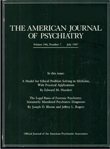Childhood-onset schizophrenia: biological markers in relation to clinical characteristics
Abstract
OBJECTIVE: The purpose of this study was to examine the relationships between clinical and neurobiological measures of childhood-onset schizophrenia. It was hypothesized that there would be a more striking pattern in the rare cases with very early onset than is seen in subjects with later onset. METHOD: Premorbid, clinical, prenatal, perinatal, and magnetic resonance imaging brain measures were examined in 29 children and adolescents who met the DSM-III-R criteria for schizophrenia with onset before age 12. Specifically, gender, premorbid adjustment, and clinical symptoms were examined in relation to cerebral volume, ventricular volume, and maternal obstetrical complications. RESULTS: Males were more likely to have had an insidious onset than females. There was a significant negative correlation between score on the Scale for the Assessment of Negative Symptoms and total cerebral volume. CONCLUSIONS: These neurobiological associations support the continuity of early-onset schizophrenia with the later-onset disorder; the striking association between smaller cerebral volume and negative symptoms suggests a more homogeneous or more potent neurobiological basis for very early-onset schizophrenia.



